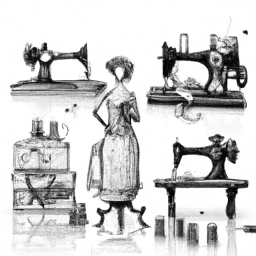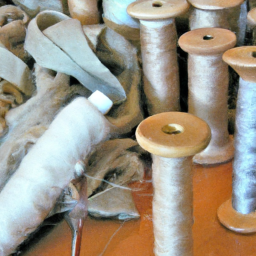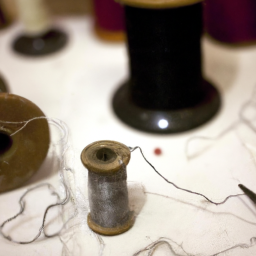In a world drenched in mass production and modern gadgets, one ancient craft remains intertwined with our lives, weaving together stories of innovation, creativity, and human ingenuity. Unearth the needle, thread your curiosity, and join us on an extraordinary journey through time as we delve deep into the enthralling tale of sewing.
From the moment our ancestors first discovered the power of the needle and thread, they stumbled upon an art form that would forever shape our relationship with garments, textiles, and the very fabric of society. With every careful stitch, they wove together the threads of their existence, leaving behind a legacy that speaks volumes about their cultures, aspirations, and triumphs.
Centuries ago, sewing served as more than a mere utilitarian practice; it was honored as a craft that manifested creativity and symbolized status. The vitality of sewing echoed across ancient civilizations as it effortlessly traversed borders and cultural boundaries, transcending time and geography alike. Whether it was the intricate tapestries of the Byzantine Empire or the delicate silk robes worn by the emperors of the Ming Dynasty, the world witnessed a multitude of styles and techniques that breathed life into every stitch.
Throughout history, sewing acted as both a practical endeavor and a form of artistic expression. The Renaissance era became a playground for countless artisans who would magnificently embroider their emotions onto canvas, while during the Victorian age, the elite showcased their affluence through exquisite, hand-sewn garments adorned with intricate lace and delicate beadwork.
But the art of sewing went beyond individual prowess, impacting societies on a grander scale as well. It paved the way for industrial revolutions, liberated women through the advent of ready-to-wear fashion, and even played a crucial role in times of war, where needlework became a symbol of resilience and hope.
In this quest to unravel the hidden depths of sewing, we will unearth long-forgotten techniques, shed light on forgotten masterpieces, and explore the technological advancements that have revolutionized the craft. We will travel back in time, exploring the stitches that held societies together and the pioneers who stitched their way into the annals of history.
Through interviews with contemporary artisans and experts, we will witness the enduring allure of sewing and uncover how it continues to resonate with people in the 21st century. Whether it be through the rise of sustainable fashion or the painstaking efforts of dedicated quilters, we will celebrate the resounding impact that threads and needles have had on our collective imagination.
Join us as we thread our way through the countless centuries and unravel the fascinating story of sewing. Prepare to be captivated by the stitches of the past, the present, and the infinite possibilities they hold for the future. 
 rn
rn
Early Origins: Tracing the Evolution of Sewing Techniques
rn
Embroidery, an exquisite form of needlework, has captivated artisans and enthusiasts for centuries. Its rich history can be traced back to ancient civilizations such as Egypt, China, and Persia, where skilled craftsmen adorned clothing and textiles with intricate designs using needles and threads. The artistry of embroidery has evolved over time, with each culture lending its unique style and techniques. From the delicate silk threads of traditional Chinese embroidery to the vibrant colors and patterns of Indian phulkari, exploring the world of embroidery unveils a tapestry of diverse and fascinating traditions.
rn
Revolutionizing the Fashion Industry: Sewing Machines and the Rise of Mass Production
rn
With the invention of the sewing machine in the 19th century, the fashion industry experienced a monumental shift. This innovation, pioneered by visionaries like Elias Howe and Isaac Singer, revolutionized the process of stitching and assembling garments. The efficiency and speed offered by sewing machines brought about the rise of mass production, making fashionable clothing more accessible and affordable to people from all walks of life. As the demand for clothing grew, so did the creativity and diversity of sewing techniques, as manufacturers sought to meet the ever-changing tastes and trends of consumers.
Q&A
Q: What is the significance of the title “”?
A: The title intertwines the concepts of threads, which symbolize the physical aspect of sewing, with the notion of time, emphasizing the historical journey that sewing has taken throughout civilization.
Q: How does sewing connect us to our ancestors?
A: Sewing is a timeless craft passed down through generations, connecting us to our ancestors who relied on this skill for survival, comfort, and self-expression. By engaging in sewing, we honor their legacy and preserve their traditions.
Q: What are some early examples of sewing throughout history?
A: Throughout history, early examples of sewing can be traced back to the Paleolithic era, where archaeologists discovered evidence of bone needles and thread made from animal sinew. This showcases the ingenuity and resourcefulness of our ancient predecessors.
Q: How has sewing evolved over time?
A: Sewing has evolved from a simple necessity to a highly sophisticated craft. What began as basic repairs and functional creations has flourished into intricate embroidery, delicate lacework, and fashionable clothing. It reflects not only technical advancements but also the changing aesthetic tastes and cultural influences of each era.
Q: What impact did the Industrial Revolution have on sewing?
A: The Industrial Revolution revolutionized the sewing industry, marking a shift from labor-intensive handwork to mechanized production. The invention of the sewing machine by Elias Howe and subsequent improvements by Isaac Singer drastically increased efficiency, making garments more accessible and affordable for the masses.
Q: How has sewing influenced fashion?
A: Sewing has played a pivotal role in shaping the history of fashion. Beyond functional garments, it has enabled the creation of intricate designs, embellishments, and tailoring that define various eras of style. From haute couture to everyday wear, the artistry of sewing remains evident in the clothes we wear.
Q: Is sewing still relevant in the modern era?
A: Absolutely, sewing continues to be relevant and cherished in the modern era. While mass-produced clothing dominates the market, there has been a resurgence of interest in handmade and sustainable fashion. Sewing allows individuals to express their unique style, contribute to slow fashion movements, and reduce their environmental footprint.
Q: How has technology impacted sewing today?
A: Technology has revolutionized the sewing world with advancements such as computerized sewing machines, digital patterns, and high-tech fabrics. These innovations have made sewing more accessible to newcomers and expanded the possibilities for creativity and precision in the craft.
Q: What can we learn from the story of sewing?
A: The story of sewing teaches us about the ingenuity, creativity, and resilience of humanity. It reminds us that even the simplest of tasks can evolve into profound art forms that connect us across time and cultures. Furthermore, sewing teaches us patience, attention to detail, and the importance of honoring traditions while embracing innovation.
Final Thoughts
As we continue to thread through the rich tapestry of history, we unravel the fascinating story of sewing. From the humble needle and thread to intricate machines, this age-old craft has stitched its way into the fabric of humanity. It has not only shaped our clothes, but also the very essence of who we are as a society.
Throughout time, sewing has been a humble companion, patiently working its magic on the fibers of our existence. It has witnessed the birth of fashion trends, the rise and fall of empires, and the painstaking journey towards progress. From ornate garments crafted for royalty to carefully mended patches on a worn-out shirt, sewing has played an invaluable role in shaping our identities.
But sewing is more than just a means of clothing ourselves. It acts as a bridge between generations, passing down stories and traditions through the seams of each carefully crafted piece. It binds cultures together, connecting threads of diverse backgrounds and weaving them into a vibrant tapestry of shared experiences.
Our journey into the world of sewing has unraveled tales of innovation and perseverance. We have delved into the ancient origins of stitching, where primitive techniques evolved into intricate patterns. We have marveled at the ingenuity of early sewing machines, which revolutionized the industry and empowered countless artisans. And we have explored the modern era, where sewing has become an art form, a source of solace, and a means of self-expression.
As we conclude our exploration of this captivating craft, let us appreciate the threads that silently tie us all together. Sewing, with its quiet charm, stitches not only fabrics but also hearts, connecting us in ways we may never fully understand. It reminds us that although we may be woven from different threads, we are all part of the same tapestry—each strand contributing to the vibrant mosaic of human existence.
So, dear reader, as the needle makes its final stitch, we bid farewell to the captivating journey of unraveling the story of sewing. Let us carry this newfound knowledge with us, cherishing the artistry of those who stitched before us and embracing the transformative power of a needle and thread. For in doing so, we preserve the intricate threads that link our past, present, and future—forever connecting us through the enduring beauty of sewing.





“I’m really looking forward to hearing the stories behind each stitch!”
Loveja Amos: “Such an interesting topic! I can’t wait to find out more”
Kaitlyn Roberts: “My mama taught me to sew, so this topic is close to my heart!”
Nina Anne: “I just love that the story of sewing is so intertwined with the history of humanity!”
Jaimelyn Bell: “I’m so excited to explore this untold history and uncover these threads through time!”
Ameera Ali: What an amazing journey we’re about to embark on! I’m ecstatic to follow each unique thread and learn the secrets of sewing!
Embarking on an adventure of exploration and discovery into the history of sewing – I’m ready to unravel this fascinating story!